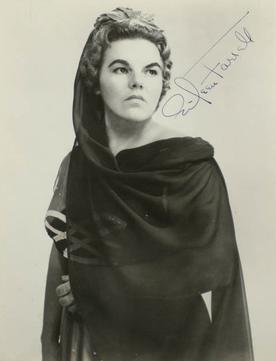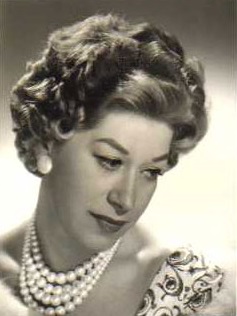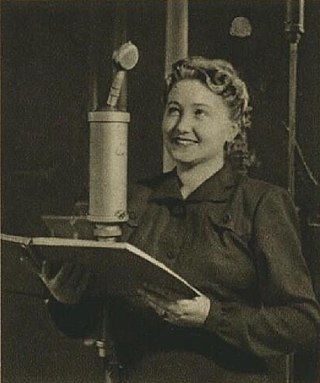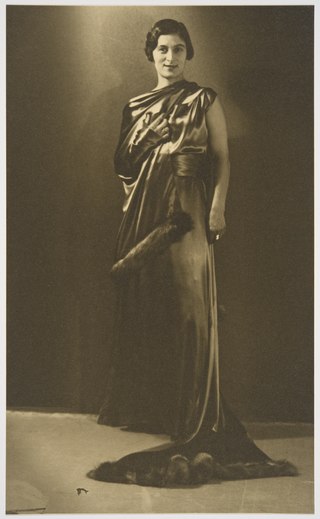Career
In 1959, at the age of 20, Driessen made her debut in the title role of Lakmé by Léo Delibes at the Vlaamse Opera in Ghent and the Opéra Royal de Wallonie in Liège. She made her Dutch debut at the De Nederlandse Opera (DNO) in Amsterdam as Leïla in Bizet's Les pêcheurs de perles , and was then engaged at the house as the first coloratura soprano.
Over the following years, she sang all main roles of her voice type at the great opera houses of Europe. Later in her career she added to her repertoire classical operetta and musical. She made much furor as Gilda in Verdi's Rigoletto , Olympia in Offenbach's Les contes d'Hoffmann , and Adele in Die Fledermaus by Johann Strauss.
Her extensive opera, operetta and musical repertoire consists of more than 70 leading roles. She was a frequent guest at many festivals and television programs. She has worked - among others - with Igor Stravinsky, Carlo Maria Giulini, Roberto Benzi, Bruno Maderna, Robert Stolz, Elisabeth Schwarzkopf, Rudolf Schock and Arnold van Mill. She recorded several records and CDs.
A soprano ([soˈpraːno]) is a type of classical female singing voice and has the highest vocal range of all voice types. The soprano's vocal range (using scientific pitch notation) is from approximately middle C (C4) = 261 Hz to "high A" (A5) = 880 Hz in choral music, or to "soprano C" (C6, two octaves above middle C) = 1046 Hz or higher in operatic music. In four-part chorale style harmony, the soprano takes the highest part, which often encompasses the melody. The soprano voice type is generally divided into the coloratura, soubrette, lyric, spinto, and dramatic soprano.
A mezzo-soprano or mezzo (; Italian: [ˌmɛddzosoˈpraːno]; meaning "half soprano") is a type of classical female singing voice whose vocal range lies between the soprano and the contralto voice types. The mezzo-soprano's vocal range usually extends from the A below middle C to the A two octaves above (i.e. A3–A5 in scientific pitch notation, where middle C = C4; 220–880 Hz). In the lower and upper extremes, some mezzo-sopranos may extend down to the F below middle C (F3, 175 Hz) and as high as "high C" (C6, 1047 Hz). The mezzo-soprano voice type is generally divided into the coloratura, lyric, and dramatic mezzo-soprano.

Eileen Farrell was an American soprano who had a nearly 60-year-long career performing both classical and popular music in concerts, theatres, on radio and television, and on disc. NPR noted, "She possessed one of the largest and most radiant operatic voices of the 20th century." While she was active as an opera singer, her concert engagements far outnumbered her theatrical appearances. Her career was mainly based in the United States, although she did perform internationally. The Daily Telegraph stated that she "was one of the finest American sopranos of the 20th century; she had a voice of magnificent proportions which she used with both acumen and artistry in a wide variety of roles." And described as having a voice "like some unparalleled phenomenon of nature. She is to singers what Niagara is to waterfalls."

Roberta Peters was an American coloratura soprano.

A soubrette is a type of operatic soprano voice fach, often cast as a female stock character in opera and theatre. The term arrived in English from Provençal via French, and means "conceited" or "coy".

Estelle Liebling was an American soprano, composer, arranger, music editor, and celebrated voice teacher and vocal coach.

Régine Crespin was a French singer who had a major international career in opera and on the concert stage between 1950 and 1989. She started her career singing roles in the dramatic soprano and spinto soprano repertoire, drawing particular acclaim singing Wagner and Strauss heroines. She went on to sing a wider repertoire that embraced Italian, French, German, and Russian opera from a variety of musical periods. In the early 1970s Crespin began experiencing vocal difficulties for the first time and ultimately began performing roles from the mezzo-soprano repertoire. Throughout her career she was widely admired for the elegance, warmth and subtlety of her singing, especially in the French and German operatic repertories.

Mady Mesplé was a French opera singer, considered the leading coloratura soprano of her generation in France, and sometimes heralded as the successor to Mado Robin, with Lakmé by Delibes becoming her signature role internationally.

Eugénie "Ninon" Vallin was a French soprano who achieved considerable popularity in opera, operetta and classical song recitals during an international career that lasted for more than four decades.

Regina Resnik was an American opera singer who had an active international career that spanned five decades. She began her career as a soprano in 1942 and soon after began a lengthy and fruitful relationship with the Metropolitan Opera that spanned from 1944 until 1983. Under the advice of conductor Clemens Krauss, she began retraining her voice in the mezzo-soprano repertoire in 1953 and by 1956 had completely removed soprano literature from her performance repertoire.

Harolyn Blackwell is an American lyric coloratura soprano who has performed in many of the world's finest opera houses, concert halls, and theaters in operas, oratorios, recitals, and Broadway musicals. Initially known for her work within musical theater during the early 1980s, Blackwell moved into the field of opera and by 1987 had established herself as an artist within the soubrette repertoire in many major opera houses both in the United States and in Europe. Feeling that she was being "type cast" into one particular kind of role, Blackwell strove to establish herself within the lyric coloratura repertoire beginning in the mid-1990s. With the aid of such companies as Seattle Opera, Blackwell successfully made this move and is now an interpreter of such roles as Lucia in Donizetti's Lucia di Lammermoor and Olympia in Offenbach's Les contes d'Hoffman. She has also periodically returned to musical theater performances throughout her career in staged productions, concert work, and recitals. Blackwell is known for her interpretations and recordings of the works of Leonard Bernstein.

Marta Eggerth was a Hungarian actress and singer from "The Silver Age of Operetta". Many of the 20th century's most famous operetta composers, including Franz Lehár, Fritz Kreisler, Robert Stolz, Oscar Straus, and Paul Abraham, composed works especially for her.

Maria Tauberová was a Czech opera singer who had an active international career from the 1930s through the 1970s. A lyric coloratura soprano with an excellent technique, she possessed a warm bright voice that was even in all registers. She was particularly admired for her portrayal of Mozart heroines. In addition to an almost four-decade career at the Prague National Theatre, she sang throughout Europe and in South America, frequently with her husband, conductor Jaroslav Krombholc.

Pia Ravenna was a celebrated Finnish coloratura soprano who specialized in operatic works and was known as "the Nightingale of Finland". Her artist name, Pia Ravenna, was based on her nickname "Pian" and Ravenna was found on the map of Italy.
Renate Holm was a German-Austrian film actress and operatic soprano. She worked as a dentists' assistant and took private singing lessons, resulting in performances in musical films and schlager. She made her debut at the Vienna Volksoper in 1957, and moved on to the Vienna State Opera where she worked for decades. She appeared internationally and made many recordings, especially for the WDR in a series of operettas with conductor Franz Marszalek. She later worked as a voice teacher, juror at competitions, and festival manager. Her memoir was published in 2017.
Anke Sieloff is a German opera, operetta, and musical soprano and mezzo-soprano. A member of the Musiktheater im Revier, she has focused on musical roles such as Maria in West Side Story, the title characters in both Kiss Me, Kate and Evita, and a witch in the first German production of The Witches of Eastwick. She taught both classical singing and pop singing at music universities.

Auguste Götze was a German classical singer, actress, playwright, and a distinguished voice teacher. Götze was born in Weimar where she initially trained in music with her father, the tenor Franz Götze. In her later years, she had her own singing school in Leipzig as well as teaching in the conservatory there. She died in Leipzig at the age of 68 after several years of increasingly poor health.

Margaret Winifred Gale is an English operatic soprano who sang leading roles with Sadler's Wells Opera Company throughout the 1960s and early 1970s.
Anne Lünenbürger is a German operatic soprano and Bavarian Kammersängerin.

Colette D'Arville was a French soprano and musical theatre actress who had an international career in operas, concerts, and musicals from the 1920s through the 1940s. Born Marie Marthe Cescosse, she began her career at the Théâtre des Bouffes-Parisiens from 1922 to 1927 with the stage name Colette Etchery, she changed her stage name to Colette D'Arville for her United States debut in the 1928 Broadway musical Here's Howe. She was active with the Opéra-Comique in Paris during the 1930s, and periodically appeared in operas with American companies from 1931 to 1942 in addition to performing on American radio and in concerts and recitals. She was particularly associated with the title role in Bizet's Carmen. While principally active in live performance on the stage and radio, she starred as Chichita in the 1935 musical film Tango Bar for Paramount Pictures. She was romantically involved with composer Deems Taylor and tenor Giovanni Martinelli.















